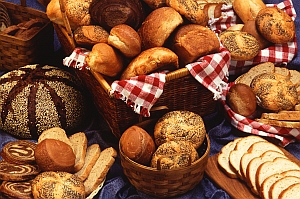Undergraduate students at Johns Hopkins University in Baltimore have genetically engineered yeast cells used in making bread to produce more beta carotene. The project that the students call VitaYeast is the university’s entry in the International Genetically Engineered Machine (iGEM) contest held 5-7 November at Massachusetts Institute of Technology.
Yeast helps make bread rise, but does not normally produce vitamins. To add this capability, the students tweak the genome of the yeast’s single-cell microbes. The tweak involves adding to yeast cells certain DNA sequences that trigger the biochemical reactions that produces beta carotene, the orange substance that gives carrots their color. When eaten, beta-carotene turns into vitamin A.
Faculty adviser Jef Boeke, a molecular biologist at the Johns Hopkins medical school, and other faculty offered lab space to the students, who turned the lab into a makeshift kitchen. The team found a simple bread-making recipe on the Web, substituted the engineered yeast for the normal dry packaged yeast, purchased a bread-making machine, and baked a loaf.
Biomedical engineering junior Steffi Liu says, “The lab smelled amazing after we baked the bread. Everybody wanted a bite of it. But obviously we can’t do that.” Liu was referring to restrictions against eating food with genetically modified ingredients until it has undergone safety testing or received approval from regulators.
Noah Young, a senior in biomedical engineering, believes the resulting product that looks and smells like un-engineered bread will overcome some of the resistance faced by genetically modified food. “We’re not genetically modifying the wheat. We’re not genetically modifying the flour or the water,” says Young. “We’re genetically modifying something like one percent of the bread recipe. When you bake VitaYeast bread and you look at it, it looks like normal bread.”
Team member Arjun Khakhar, a biomedical engineering junior, who grew up in Bombay, India, says a product like VitaYeast can solve a difficult problem in many countries resulting from the lack of nutritious foods, not necessarily a lack of food itself. “Vital nutrients like vitamins are just missing from their diets because they can’t afford fruits and vegetables,” says Khakhar. “That’s what we wanted to provide through VitaYeast.”
Another team member Ashan Veerakumar, a senior in neuroscience, plans to survey Baltimore area residents on their willingness to eat genetically modified food, particularly if it could improve their health. Team members are also searching for financial support to move the project ahead, although it would still require animal testing and regulatory reviews before it could be introduced to the market.
A video produced by the university tells more about the project.
Read more: Grad Students Develop Cord Blood Stem Cell Collection Device
* * *


 RSS - Posts
RSS - Posts
[…] Students Engineer Bread Yeast to Yield More Nutrients […]